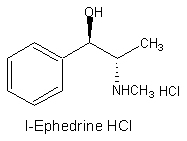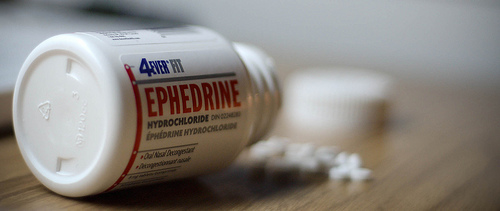
|
Ephedrine Hydrochloride USP
 |
Molecular Formula
: C10H15NO. HCl
Molecular Weight : 201.69
CAS No. : [50-98-6]
Chemical Name :
1. Benzenemethanol, œ-[1-(methylamino)ethyl]-,
hydrochloride [R-(R*,S* )], salt
2. (1R,2S)-2-Methylamino-1-phenyl propan-1-ol
Hydrochloride
Specifications :
| 1. |
Description : |
Colourless
crystals or white crystalline powder |
| 2. |
Identification : |
a) Infrared
spectrum of sample is concordant with the reference spectrum.
b) A solution of sample respond to the test for chloride. |
| 3. |
Solubility
: |
Freely soluble in
water and soluble in alcohol. |
| 4. |
Melting
range : |
Between 217° and
220°C; the range between beginning and end of melting does not
exceed 2°C |
| 5. |
Specific
rotation : |
Between - 33.0°
and - 35.5° ( 5 % solution in water ) |
| 6. |
Acidity &
alkalinity : |
NMT 0.10 ml of
0.02 N H2SO4 or NMT 0.20 ml of 0.02 N
NaOH solution |
| 7. |
Sulfate : |
Must pass the
test. No turbidity develops within 10 min. |
| 8. |
Ordinary
impurities : |
NMT 2.0 % |
| 9. |
Residue on
ignition : |
NMT 0.1 % |
| 10. |
Loss on
drying : |
NMT 0.5 % |
| 11. |
Organic
volatile impurities : |
Must pass the test |
| 12. |
Assay : |
Between 98.0 % and 100.5 % (
dried basis ) |
Therapeutic indications : Bronchodilator
Packing : Packed in double lined polyethylene
bags in 25 kg fiber drums.
Storage : Store below 35°C. |
 Ephedrine
(EPH) is a sympathomimetic amine commonly used as a stimulant,
appetite suppressant, concentration aid, decongestant, and to treat
hypotension associated with anaesthesia. Ephedrine is similar in
structure to the synthetic derivatives amphetamine and methamphetamine.
Chemically, it is an alkaloid derived from various plants in the genus
Ephedra (family Ephedraceae). It is most usually marketed in the
hydrochloride and sulfate forms. Ephedrine
(EPH) is a sympathomimetic amine commonly used as a stimulant,
appetite suppressant, concentration aid, decongestant, and to treat
hypotension associated with anaesthesia. Ephedrine is similar in
structure to the synthetic derivatives amphetamine and methamphetamine.
Chemically, it is an alkaloid derived from various plants in the genus
Ephedra (family Ephedraceae). It is most usually marketed in the
hydrochloride and sulfate forms.
Chemistry
Ephedrine exhibits optical isomerism and has two chiral centres. By
convention the enantiomers with opposite stereochemistry around the
chiral centres are designated ephedrine, while pseudoephedrine has same
stereochemistry around the chiral carbons. That is, (1R,2R)- and
(1S,2S)-enantiomers are designated pseudoephedrine; while (1R,2S)- and
(1S,2R)-enantiomers are designated ephedrine.
The isomer which is marketed is (-)-(1R,2S)-ephedrine.
As with other phenylethylamines, it is also somewhat chemically similar
to methamphetamine, although the amphetamines are more potent and have
additional biological effects.
These terms are used to refer to the same substance derived from the
plant Ephedra. (There are many common names for these evergreen plants,
including squaw tea and Mormon tea.) Ephedra is a shrub-like plant that
is found in desert regions in central Asia and other parts of the world.
The dried greens of the plant are used medicinally. Ephedra is a
stimulant containing the herbal form of ephedrine, an FDA-regulated drug
found in over-the-counter asthma medications.
In the United States, ephedra and ephedrine are sold in health food
stores under a variety of brand names. Ephedrine is widely used for
weight loss, as an energy booster, and to enhance athletic performance.
These products often contain other stimulants, such as caffeine, which
may have synergistic effects and increase the potential for adverse
effects. Ephedra is often touted as the "herbal fen-phen."
Ephedra's main active medical ingredients are the alkaloids ephedrine
and pseudoephedrine. The ephedras also contain various tannins and
related chemicals.The stem contains 1-3% total alkaloids, with ephedrine
accounting for 30-90% of this total. The concentrations of these
alkaloids depends upon the particular species of ephedra used.
Clinical use
Ephedrine Sulphate (1932) Ephedrine Compound (1932) and Swan-Myers
Ephedrine Inhalant No. 66 (ca. 1940)
Indications
In traditional Chinese medicine, ephedrine has been used in the
treatment of asthma and bronchitis for centuries.
An ECA stack is a component found in thermogenic weight loss pills,
composed of ephedrine, caffeine and aspirin (many supplement
manufacturers include salicin instead of aspirin) working to speed up
the metabolism and thus cause food energy to burn faster. The ECA stack
is a popular supplement taken by body builders before workouts due to
the increased amount of energy and alertness.
Recreational and illicit use
Anecdotal reports have suggested that ephedrine helps studying,
thinking, or concentrating to a greater extent than caffeine. Some
students and some white-collar workers have used ephedrine (or Ephedra-containing
herbal supplements) for this purpose, as well as some professional
athletes and weightlifters. It is common for many athletes to use
stimulants while exercising. Such use of ephedrine has been associated
with stimulant dependence, as well as deaths from heatstroke in athletes
and circulatory problems such as aortic aneurysm in weightlifters,
though these side effects are rare.As a phenylethylamine, ephedrine has
a similar chemical structure to amphetamines. Ephedrine can be used in
the synthesis of methamphetamine by chemical reduction; this has made
ephedrine a highly sought-after chemical precursor in the illicit
manufacture of methamphetamine. The most popular method for reducing
ephedrine to methamphetamine is similar to the Birch reduction, in that
it uses anhydrous ammonia and lithium metal in the reaction. The second
most popular method uses red phosphorus, iodine, and ephedrine in the
reaction.
 Note:
These API/ chemicals are designated as
those that are used in the manufacture of the controlled substances and
are important to the manufacture of the substances. For any (Control
Substance) products Import and Export *** subjected to your country
government laws /control substance ACT. Note:
These API/ chemicals are designated as
those that are used in the manufacture of the controlled substances and
are important to the manufacture of the substances. For any (Control
Substance) products Import and Export *** subjected to your country
government laws /control substance ACT.
Note /Government Notification:
These chemicals are designated as those that are used in the manufacture
of the controlled substances and are important to the manufacture of the
substances. For any (Control Substance) products Import and Export ***
subjected to your country government laws /control substance ACT.
Information: The information on this web page is provided to help you
to work safely, but it is intended to be an overview of hazards, not a
replacement for a full Material Safety Data Sheet (MSDS). MSDS forms can
be downloaded from the web sites of many chemical suppliers. ,also that
the information on the PTCL Safety web site, where this page was hosted,
has been copied onto many other sites, often without permission. If you
have any doubts about the veracity of the information that you are
viewing, or have any queries, please check the URL that your web browser
displays for this page. If the URL begins "www.tajapi.com/www/Denatonium
Benzoate.htm/" the page is maintained by the Safety Officer in Physical
Chemistry at Oxford University. If not, this page is a copy made by some
other person and we have no responsibility for it.
The Controlled Substances Act (CSA) was enacted into law by the Congress
of the United States as Title II of the Comprehensive Drug Abuse
Prevention and Control Act of 1970.[1] The CSA is the federal U.S. drug
policy under which the manufacture, importation, possession, use and
distribution of certain substances is regulated. The Act also served as
the national implementing legislation for the Single Convention on
Narcotic Drugs.

|
|





 Ephedrine
(EPH) is a sympathomimetic amine commonly used as a stimulant,
appetite suppressant, concentration aid, decongestant, and to treat
hypotension associated with anaesthesia. Ephedrine is similar in
structure to the synthetic derivatives amphetamine and methamphetamine.
Chemically, it is an alkaloid derived from various plants in the genus
Ephedra (family Ephedraceae). It is most usually marketed in the
hydrochloride and sulfate forms.
Ephedrine
(EPH) is a sympathomimetic amine commonly used as a stimulant,
appetite suppressant, concentration aid, decongestant, and to treat
hypotension associated with anaesthesia. Ephedrine is similar in
structure to the synthetic derivatives amphetamine and methamphetamine.
Chemically, it is an alkaloid derived from various plants in the genus
Ephedra (family Ephedraceae). It is most usually marketed in the
hydrochloride and sulfate forms.




